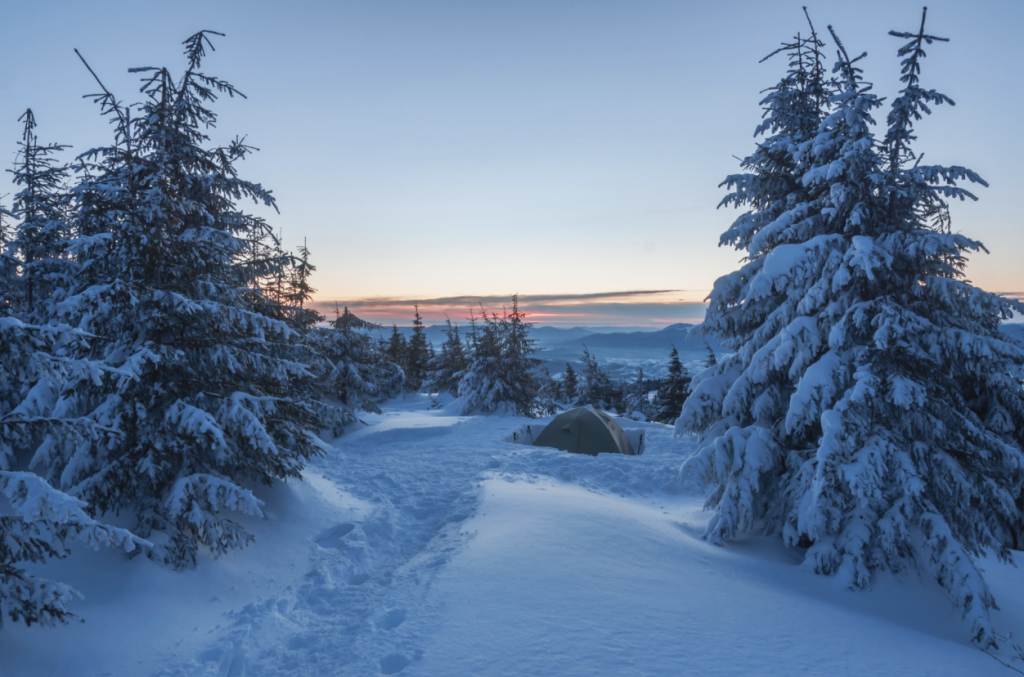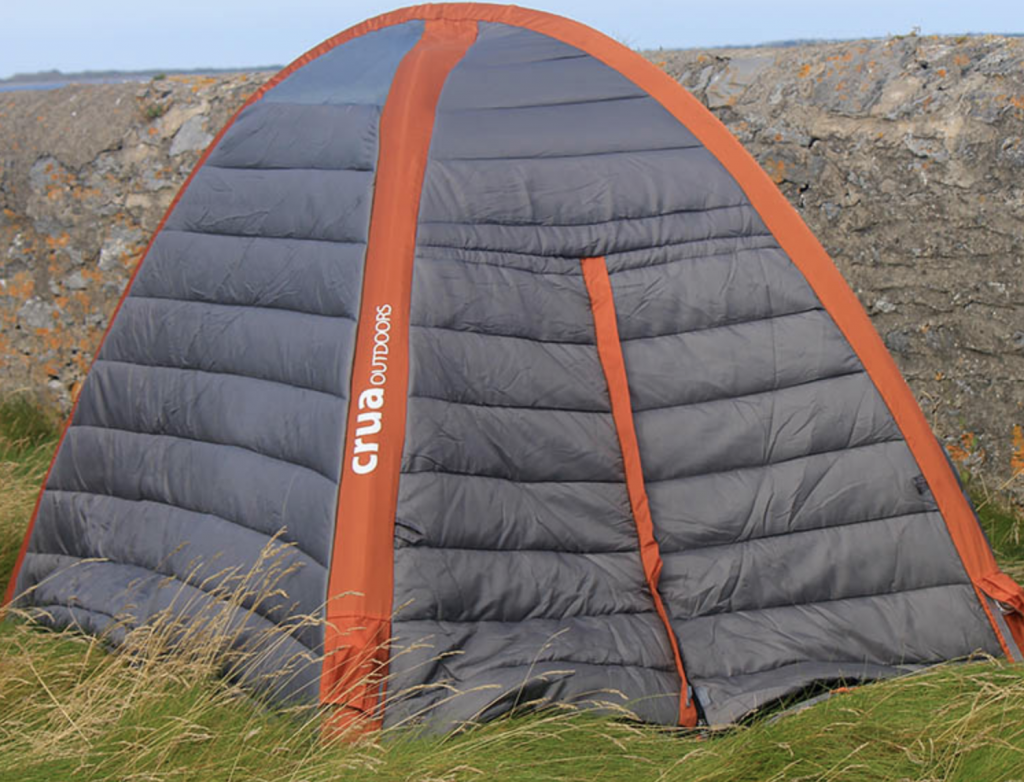When I began camping in chillier conditions, the first question I asked was, are tents insulated?

Most tents are not well-insulated from the weather or noises. A tent will trap some of your body heat and reduce wind chill, but any warmth will quickly dissipate through the air vents. However, there are options for staying warm in a tent, including buying an insulated one, insulating your existing tent, and using insulating sleeping gear.
I arrived at this answer based on my own camping experiences and 5+ hours of research on how insulation works.
I will discuss below exactly why most tents are poor insulators and what you can do about it. And you can insulate your tent without getting condensation.
How Well Are Tents Insulated From the Weather?
The temperature within a tent will be the same as or slightly above (5 – 10 F) the temperature outside. The tent provides a semi-enclosed space, so it does trap some of your body heat and heat from the sun. And there’s also less windchill.
But it wouldn’t take long for any heat within your tent to dissipate, and the temperatures inside can drop quickly after sunset. Two main reasons for this: thin fabrics and ventilation.
Insulation works by slowing down the transfer of heat. This is the core principle that underpins all of our discussion in this article.
If that’s a little too technical, think about your down jacket. It has two main layers filled with air and feathers in between. For the heat to leave your body, it has to travel through the fabrics and millions of tiny feathers loosely connected with one another.
Compare this to your typical tent, which only has one or two layers of thin fabrics with nothing in between. The heat will travel much faster through your tent fabrics.
Airflow also affects how much insulation you get. This is very intuitive if you think about opening your window in the summer to cool down.
And all tents have some kind of ventilation, be it a vent, a window, or meshed walls. And warm air escapes through them.
That being said, some tents provide much better insulation than others. We will go over those later in the article, but they tend to be more expensive.
Do Rain Flies Keep You Warm?
A rainfly will keep your tent slightly warmer. Still, it will not provide the necessary insulation to keep you warm throughout the night.
Why is this the case? Well, a rainfly reduces airflow and adds an additional layer of fabric, so it slows down any heat loss. But this is insufficient because rain flies are quite thin, and most of them do not cover the tent top to bottom.
In short, don’t count on your rainfly to keep you warm. Here are some ways to properly insulate your tent.
How Well Are Tents Insulated From Noises?
Based on my experiences, tents are not insulated from outside noises at all. I can easily hear what the other campers are talking about. Again, nothing in the construction of tents absorbs sound or slows down the transfer.
To deal with this problem, you can either bring earplugs or choose campgrounds where campsites are further away from each other.
What Tents Come With Insulation?
Today, there are three options: canvas tents, 4-season tents, and Crua Outdoors tents. The first two offer better insulation, but the temperature will eventually get close to the outdoors if you leave the tents outside long enough. Only the Crua Outdoors tents provide complete insulation.
Canvas Tents
Canvas tents offer better insulation because of their thicker fabrics. Again, it would take much longer for heat to get in or out of the tent.
On top of that, the canvas is also breathable, which means less condensation, less airflow to stay ventilated, and warmer for longer.
This is aligned with my personal experiences. When camping during the colder months in Lake Tahoe, where temperatures drop to the low 30s, I rented a canvas tent a few times. The comfort difference between a canvas tent and a regular one is quite obvious. I no longer need 30F-rated sleeping bags or to change into my sleeping clothes as quickly as possible to avoid the cold.
I know you might think to yourself: “But I’ve never seen a canvas tent on the market!” Yes, they are less common today and used more often for glamping.
But it’s inaccurate to assume that all canvas tents are huge glamping tents or bell-shaped. Kodiak Canvas offers many options that would fit into a regular-sized car camping site.
The only downsides are the bulkiness and cost. For example, even an 8.5ft x 6ft canvas tent weighs around 35 pounds and costs $370. Such weight is hard to manage even for car camping, and backpacking with it is impossible.
But hey, if you prioritize comfort, you can’t go wrong with a canvas tent. You can also learn more about the pros and cons of each material here.
4-Season Tents
You’ve probably come across 4-season tents if you researched camping in cold weather.
But the “4-season” rating is a bit of a misnomer. Most 4-season tents would be too warm or stuffy if you try to use them during the summer.
And during the winter, most won’t keep you warm unless you have the right sleeping gear. In other words, the tent alone won’t provide enough insulation.
Take this MSR 4-season tent, for example. It’s still made of thin nylon fabrics with no insulating layer. It’s only slightly warmer than a 3-season tent because it has fewer meshed walls.
The key selling point of 4-season tents over 3-season ones is their strength and sturdiness in extreme weather conditions. The poles and design are built to handle high winds and large amounts of snow. But most of you won’t be camping in those conditions anyways.
Crua Outdoors Tents
Crua Outdoors is pretty much the only brand I found on the market that produces truly insulated tents.
As you can see below, it’s made of thick insulating material, similar to what you would find on your down jacket. It’s very different from the fabrics used on most 4-season tents.

How to Properly Insulate Your Tent
Maybe you don’t want to buy an insulated tent but still want to stay warm. We’ve got some great tips on how to do that. You can use all the methods below in combination with one another.
This will take some DIY, so feel free to skip to the next section for other ways to stay warm in your tent. It’s unnecessary to insulate your tent in most cases, as the right sleeping gear should keep you warm.
I think it’s a common misconception that insulating your tent will lead to condensation, where moisture builds up on your tent walls and forms tiny droplets.
Sure, if you block the vents or windows to stop the hot air from flowing out, you will make the ventilation much worse and trap moisture within.
But remember, reducing airflow is not the only way to improve insulation. Think back to the down jacket example and canvas tents. You can make your tent retain heat longer by adding thicker or puffier materials. As long as you don’t block the vents, moisture will get out just fine.
Use a Thermal Blanket As An Inner Layer
Again, the key to insulation is to slow down the heat transfer. Adding a thermal blanket with duct tape as your tent’s inner layer will make your tent walls thicker.
Most thermal blankets are also reflective on one side, which means they will reflect your body heat back into the tent instead of letting it escape.
The reverse is true if you attach the thermal blanket to the exterior of your tent. The reflective coat will reflect sunlight back outside, keeping your tent cooler.
Be careful to block the vents as little as possible when doing this. Otherwise, condensation may build up. If you want to avoid it altogether, consider using a tent dehumidifier.
Put Down A Ground Tarp
Putting down a ground tarp will not only improve the insulation of your tent floor but also make your tent last longer.
Believe it or not, you actually lose much more body heat to the ground than to the air around you since soil conducts heat better than air. So insulating your tent floor can make quite a difference.
Creating a Wind Block
Besides adding more materials, you can reduce the strength of the wind that reaches your tent.
It’s actually straightforward — simply set up a tarp (or several of them) vertically in the path of the wind before it reaches your tent. This essentially forms a wall that breaks the wind.
Make sure the tarp is fully unfolded but not 100% taut when all four corners are tied to trees. Otherwise, it may either flap around or rip when it gets windy.
The closer you can set it up to your tent, the better it will block the winds.
Sometimes, you can’t predict which direction the wind will blow, so putting up multiple tarps around your tent in different positions will minimize the breeze coming through.
Other Things You Need to Stay Warm in a Tent
Even if you have successfully insulated your tent, you still need the appropriate sleeping gear to keep you warm.
Sleeping Pads or Cots
Again, since you lose more body heat to the ground than the air around you, a well-insulated sleeping pad is crucial in keeping you warm in cold weather. But how do you determine this?
The R-value is a universal measure of insulation. A higher R-value means better insulation.
Generally speaking, pads with R-value under 2 should be used for summer camping only. Those with R-value between 2 and 4 are suitable for spring and fall. Only those with R-value greater than 4 should be used for camping below freezing.
If you don’t want to invest in a new sleeping pad, consider using your thinner sleeping pad combined with a cot.
Since cots are raised from the ground and surrounded by air, you will need a thinner sleeping pad on top of it than when you sleep on the floor to achieve the same insulation level.
I don’t really recommend air mattresses since they are very poor insulators.
If you want to learn more about cots vs. air mattresses vs. pads, check out this article.
Sleeping Bags and Liners
The key here is to pay attention to the temperature rating, which is the lowest temperature at which the sleeping bag can keep you warm. But there are several caveats to this:
This is pretty much the lowest temperature you can survive, not thrive. To feel comfortable, buffer the temperature by 10 – 20F. So, for instance, if you know the temperature at your campsite will drop to 50F at night, then get a sleeping bag rated for 35F.
Generally speaking, sleeping bags with temperature ratings from 30 – 40F are built for summer camping. For freezing weather, you need a sleeping bag rated 15F or lower.
Temperature ratings of sleeping bags are also dependent on the R-value of the sleeping pad. REI has an informative table (screenshot below):

With the same temperature rating, a mummy-style sleeping bag would be the warmest since you can tighten it around the hood and cinch out the extra air. By contrast, a rectangular sleeping bag would allow for more airflow resulting in chillier conditions.
If you don’t want to invest in a new sleeping bag, and your campsite won’t get too cold, consider sleeping bag liners. You can use them to adjust the warmth and insulation.
Warm Clothing
Bring a few extra layers, like sweatshirts and sweatpants, on top of your pajamas. And clothing made of fleece will tend to be the warmest.
Oh, and never sleep with wet clothes on! Moisture will make insulation a lot worse and make you feel colder.














